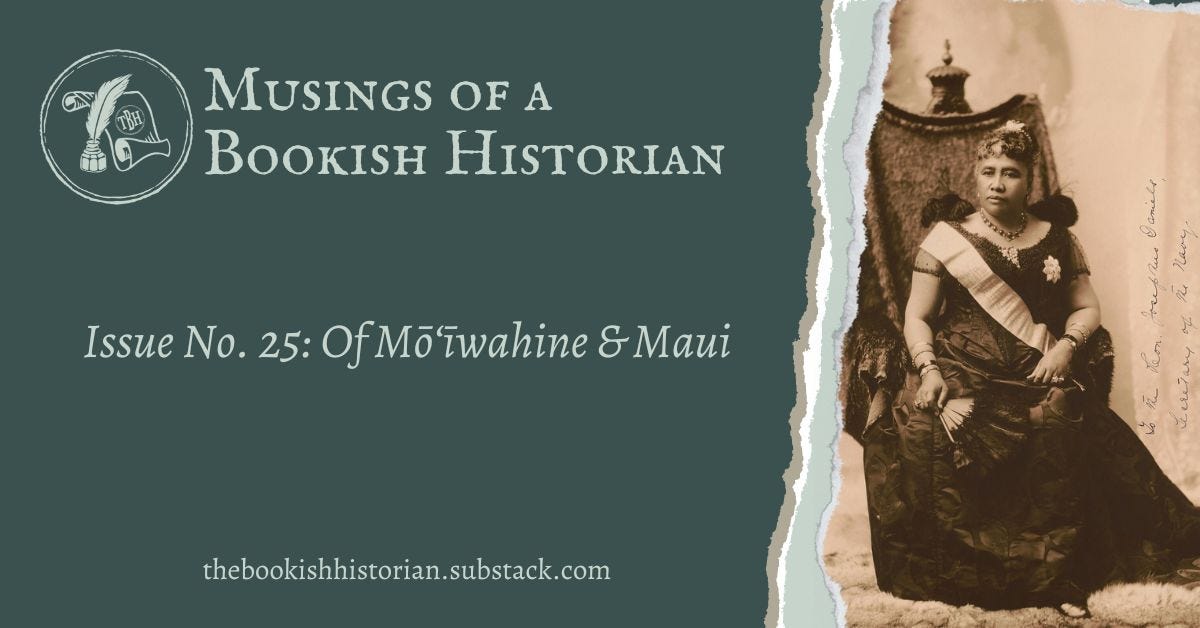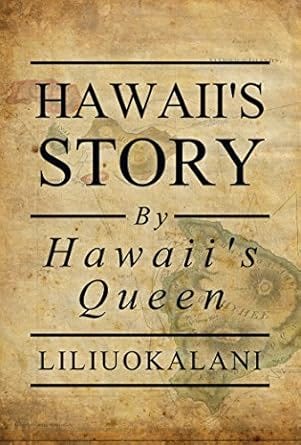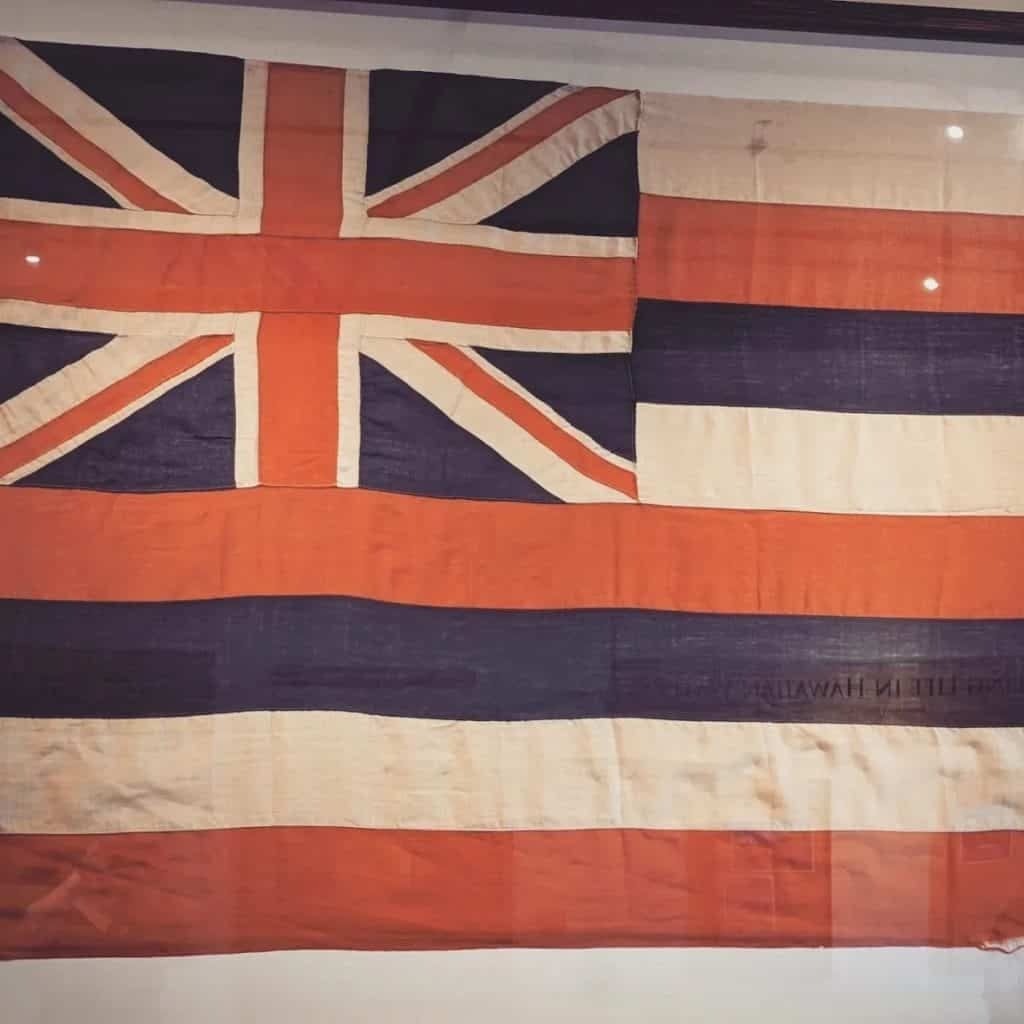Issue No. 25: Of Mōʻīwahine & Maui
The story of Queen Lili'uokalani, the last queen of the Kingdom of Hawai'i
(This particular post is quite long and does not fit in email format. To read the full post, please click in the article or check out the post via the Substack app or website!)
(Author’s note: Mōʻīwahine is the Hawaiian word for “queen”.)
Welcome back, dear readers, to the latest issue of Musings! Thank you for your patience over the last few weeks. I’ve been neck-deep in setting up an Etsy store and updating The Scroll & Quill online store. Now that things have eased up (who am I kidding?), I am looking forward to continue writing, both here, and eventually on my revamped website.
So, what am I focusing on in this issue? Queen Lili’uokalani! This fascinating woman ruled over the Kingdom of Hawai’i prior to its American annexation in the late 19th century. Sadly, her story demonstrates America’s historical lack of regard for indigenous rulers and culture. And yet, there’s something hopeful about her story as well - a reminder that those interested in Hawaiian history should show a deep respect for the kama'āina, or “children of the land”.
I hope you learn a little this week about the nation of Hawai’i and its culture and come to appreciate it as much as I do!
Queen Lili’uokalani: Five Things You May Not Know
Prior to 1893, Hawai’i was not an American state or territory. Rather, it successfully operated as a monarchy for well over a hundred years. The Kingdom’s last ruler, Queen Lili’uokalani, presided over the monarchy’s tragic fall as the result of a coalition of anti-monarchists, politicians, annexationists, and other factions. Queen Lili’uokalani was an intelligent, powerful woman whose history is not covered well in American history classes.
Never heard of her before? Well, here’s your chance to learn more! Check out five fascinating facts about my favorite Hawaiian queen.
#1: Lili'uokalani descended from nobility
Founded in 1795 by Kamehameha the Great (Kamehameha I), the kingdom of Hawai'i saw two distinctive dynasties at its helm: the House of Kamehameha and the House of Kalākaua. Lili'uokalani and her brother David, Hawai'i's last king, formed part of the House of Kalākaua. Both of the ali'i class (traditional Hawaiian nobility), they descended from two of the five royal counselors to Kamehameha I during his conquest of the Hawaiian islands.
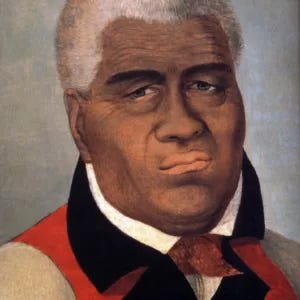
Lili'uokalani, though the House of Kalākaua's last monarch, was distantly related to the House of Kamehameha. Her maternal great-grandfather Keawe-a-Heulu and Kamehameha I's father Keōua were cousins. The House of Kalākaua's relation to the Kamehameha line and their high bloodline solidified their suitability for the throne after the last Kamehameha monarch, Lunalilo, died in 1874.
#2: She composed hundreds of songs
Lili'uokalani possessed a gift for music and composition. Her teachers recognized her gifts as a child, and her education and aptitude continued well into her adulthood.
To compose was as natural to me as to breathe; and this gift of nature, never having been suffered to fall into disuse, remains a source of the greatest consolation to this day.1
She's particularly noted for composing the "Hawaiian National Anthem" and "Aloha 'Oe" among possibly hundreds of others. When people think of Hawai'i, they often associate it with the tranquil but somber "Aloha 'Oe". But my guess is that few people know Lili'uokalani composed it!
#3: The queen's brother designated her "Lili'uokalani"
Writing in Ke Ola Magazine, Jan Wizinowich reflects that "When a Hawaiian name is bestowed, a connection is made, a story told, history preserved, someone honored, a hope expressed."2
Dowager Queen Elizabeth Kīnaʻu (the wife of the former Hawaiian king Kamehameha II) gave Lili'uokalani her birth name of Lydia Lili'u Loloku Walania Kamaka'eha. The name, comprised of the words for "smarting," "tearful," "a burning pain", and "sore eyes", reflected the regent's suffering from an eye infection at the time of Lili'uokalani's birth.3
After naming his sister his heir apparent on April 10, 1877, King David Kalākaua proclaimed her official title as Lili'uokalani.4
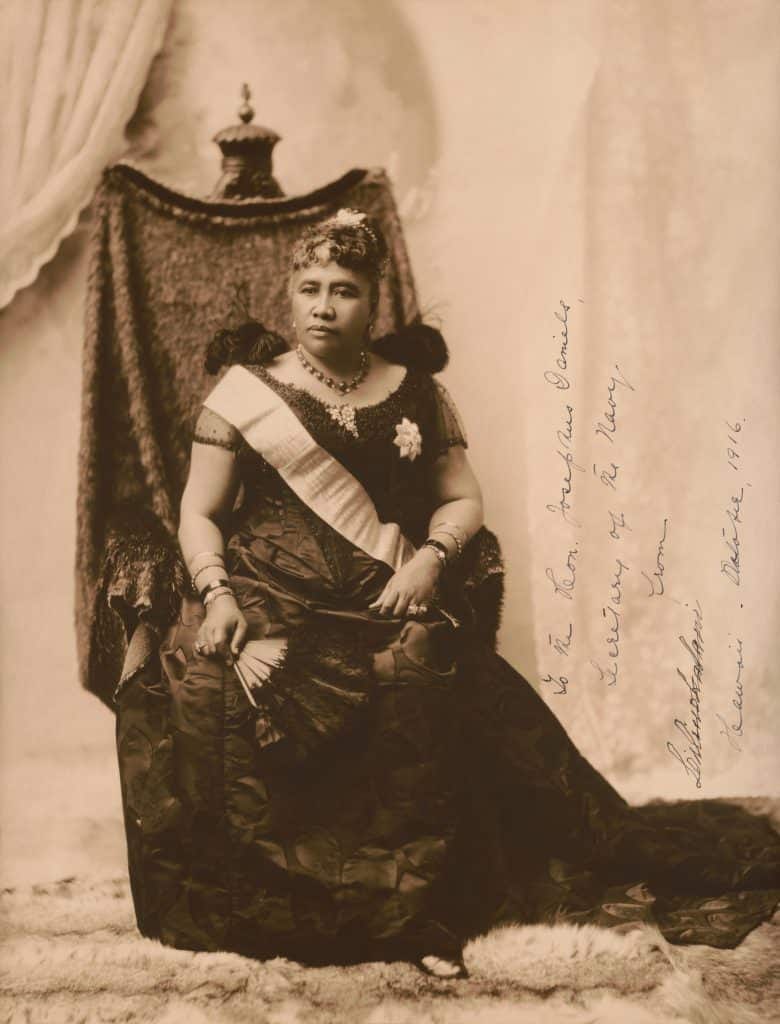
#4: Lili'uokalani met and admired Queen Victoria
Queen Victoria celebrated her Jubilee, the 50th anniversary of her reign, in 1887. She invited Queen Kapi'olani, King Kalākaua's wife; Lili'uokalani; and other Hawaiian royals to England to join in the festivities. In accordance with their royal station, Victoria showed them great favor:
Succeeding [previous royalty] came the Queen of the Hawaiian Islands with myself, and to us was accorded the most unusual honor of an escort drawn from the Life Guards of Her Majesty Queen Victoria. This was scarcely expected...when we spoke of the high appreciation we felt of this and all the attentions we had received, we were assured in response, that, as we had come such a long distance to do honor to the occasion, Her Majesty had thought that the least she could do was to provide us special honors.5
To that end, Queen Kapi'olani and Lili'uokalani sat amongst other important guests on a raised dais during the Jubilee ceremony at Westminster Abbey. These included Princess Augusta of Cambridge, the Grand Duchess of Mecklenburg-Strelitz; and Marie Henriette of Austria, Queen of the Belgians.
Lili'uokalani later kindly recalled Victoria as a "well-proportioned, gracious, queenly woman...[with] a kind, winning expression on her face which gave evidence of the gentle spirit within."6 It's clear that Lili'uokalani saw a kindred spirit in her sister monarch.


#5: Lili'uokalani experienced an open-sleigh ride
History well recognizes the facts of Lili'uokalani's life, especially in relation to her reign. They do not, however, always provide insight into some of the more informal aspects of one's life. Take, for instance, Lili'uokalani's experience with sleighing. While en route to Washington D.C. to treat with President Grover Cleveland in 1897, the queen and her entourage spent time with friends in Boston. During this time, they experienced a true New England winter activity:
It was a bright and beautiful day when the jingling bells and prancing horses acquainted me with the much-praised experience of sleigh-riding...In truth, I must say I failed to see the delight and exhilaration of the sport, although I enjoyed the afternoon very much indeed; but if I had had the same charming companions on a good road with an easy-riding carriage, it seems to me the pleasure of the ride would have been greater.7
The Hawaiians may not have liked that particular activity. On the other hand, this passage offers a unique insight into Lili'uokalani's life. Sometimes those details fascinate me just as much as the well-known facts.
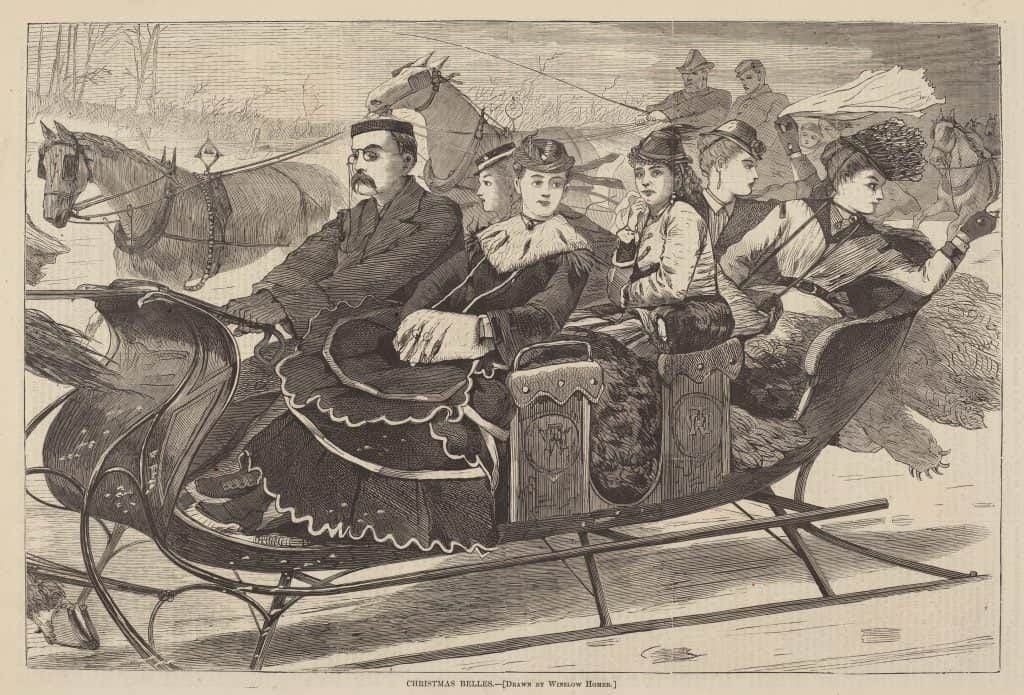
Lili'uokalani's legacy cannot be understated. This impressive woman won the hearts and respect of her people and others, including President Cleveland. In this article, I shared five facts gleaned from her memoir that I hope shed some light on this remarkable queen. To learn more, I highly recommend reading Hawaii's Story by Hawaii's Queen.
Book of the Week: Hawai’i’s Story by Hawai’i’s Queen by Queen Lili’uokalani
Queen Lili'uokalani wrote Hawai'i's Story by Hawai'i's Queen in 1898 "to explain to the world the injustice of her situation and to reclaim the sovereignty which she had lost".8 Penned five years after her overthrow, Lili'uokalani delivers her narrative in a powerful and evocative way in an effort to persuade the American government to vote against annexation.
Highly educated and musically talented, Lili'uokalani grew up as a member of the Hawaiian royal family. Born in 1838, she attended school alongside other relatives as a possible heir to King Kamehameha III. In 1877, her brother King David Kalākaua designated Lili'uokalani as his heir, vaulting her onto an ultimately tumultuous path.
Upon her ascension to the throne in 1891, Lili'uokalani met with a resistant legislature that did not want to yield the power it had enjoyed. The 1887 Bayonet Constitution stripped Kalākaua of his rights (at gunpoint, I might add), effectively placing Hawai'i under the control of an oligarchy. The queen's people asked for a new constitution that returned rights to the native people. This event precipitated the coup that ultimately replaced her in 1893 and led to further restrictions under the Republic of Hawai'i.
The memoir's later sections portray her efforts in petitioning President Grover Cleveland and later William McKinley to reassert her rights and return her to her throne. During this particular part of the book, her (completely justified, in my opinion) scathing and disdainful opinion of those who colluded to deprive her of her throne come through. In her view, no justification existed for the American coup. Lili'uokalani ends her story with the hope that the American government would vote against annexation. This, however, occurred later on July 7, 1898 after this autobiography was published.
I recommend this must-read for anyone interested in Hawaiian history. At its core, it's a tale of American imperialism and deceit. More importantly, however, readers learn the story of modern Hawai'i, its resilient people, and their history, culture, and beliefs.
Artifact of the Week: The Flag of the Kingdom of Hawai’i
As noted elsewhere in this article, a coalition of anti-monarchists, annexationists, and other politicians overthrew the Hawaiian monarchy on January 17, 1893 with the support of pro-American and pro-European factions, forcing the abdication of Queen Lili'uokalani.
The image here, taken in April 2022, show the flag of the Kingdom of Hawai'i that flew over the courthouse in Lāhainā until August 12, 1898. At that time, the flag was lowered and the American flag rose in its stead. The Kingdom of Hawai'i had officially become an American territory. Sadly, the flag, housed in the old Lāhainā courthouse, burned during the August 2023 Maui wildfires.
Artifact Description
Title: The Flag of the Kingdom of Hawai’i
Date: 19th century
Material: Cloth
Location: Old Lāhainā Courthouse, burned in August 2023
Thank you for joining me! I hope you learned something new about this incredible woman!
Cheers,
Featured image: Photograph of Queen Lili’uokalani, taken by James J. Williams, c. 1891 (Library of Congress Prints and Photographs Division, ppmsca-51350)
I am really curious, my friends. Do you enjoy the format of these biweekly posts? If not, can you please let me know how I can improve (besides the timing - I’m actively working to ensure these come out regularly!)? Or, what do you enjoy? Please feel free to fill out the poll and/or comment below!
Thank you so much for reading this issue! Please feel free to share the story of Lili’uokalani through clicking the button below! This helps to grow Musings of a Bookish Historian and honestly encourages me to keep writing!
If you’re not a subscriber, please feel free to enter your email so you can receive all of my articles, book reviews, lists, and much more! I always enjoy sharing new research and favorite books, and I’m constantly thinking of new ways to engage my readers. As always, your support drives what I do, and I’m forever grateful! :)
Ibid.
Jan Wizinowich, "Hawaiian Naming Traditions: A Cultural Legacy," Ke Ola, September-October 2020, https://keolamagazine.com/culture/hawaiian-naming-traditions/ (accessed February 6, 2023).
Julia Flynn Siler, Lost Kingdom: Hawaii's Last Queen, the Sugar Kings and America's First Imperial Adventure (New York: Atlantic Monthly Press, 2012), 32. You can also refer to the Hawaiian-English Dictionary published by the University of Hawaii Press in 1986.
Lili'uokalani, "Chapter IX: Heir Apparent," Hawaii's Story by Hawaii's Queen.
Lili'uokalani, "Chapter XXV: The Jubilee - At the Abbey - At the Palace," Hawaii's Story by Hawaii's Queen.
Ibid., "Chapter XXVIII: Ill News from Hawaii - Our Return."
Ibid., "Chapter L: A New England Winter.”
Hawaii's History by Hawaii's Queen, Goodreads, https://www.goodreads.com/book/show/32056516-hawaii-s-story-by-hawaii-s-queen (accessed January 30, 2023).





